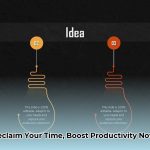Feeling overwhelmed by endless to-do lists and looming deadlines? You’re not alone. Many struggle with time management, often missing simple adjustments that could dramatically improve productivity. What if you could harness a framework that emphasizes self-awareness and a personalized plan? This guide adapts proven methods, offering practical solutions for today’s demanding world. It’s more than just using a planner; it’s about understanding your unique time habits, identifying distractions, and building a sustainable system that works for you. Discover user-tested strategies for lasting success, eliminate chaos, and reclaim control of your time. Let’s delve into time management pitfalls and construct a system that truly empowers you. For more advanced strategies, check out these time management tips.
Time Management From the Inside Out: The Key to Unlocking Your Potential
Effective time management isn’t about restrictive schedules; it’s about self-understanding and crafting a system that complements your natural rhythms. That’s the essence of “time management from the inside out.” This approach unfolds in three crucial phases: Analyze, Strategize, and Attack. Let’s dive in!
Analyze: Unveiling Your Time Audit and Habits
Before you can manage time effectively, you need to understand how you actually spend it. It’s like trying to navigate a city without a map! Dedicate a week to meticulously tracking your activities. Record everything you do and the time it consumes. You might be astonished by how much time evaporates on seemingly insignificant tasks.
Remember, this isn’t about self-criticism, but about uncovering valuable insights. Do you find yourself constantly refreshing social media feeds? Are you drowning in low-priority emails? Recognizing these patterns is the essential first step toward creating meaningful change.
Try this helpful exercise: List your top five time-consuming activities. Next to each, note the time spent and its relevance to your goals. Does the time spent reflect its importance? This exercise can reveal significant discrepancies and opportunities for adjustment.
Perhaps you’re a natural procrastinator, perpetually putting things off until the last minute. Or maybe you struggle with prioritizing, feeling paralyzed by an overwhelming to-do list. Understanding these tendencies – are they driven by habit or situation? – is crucial to developing a personalized and effective strategy.
This self-assessment isn’t a one-off task. Regularly reviewing your time usage helps you stay conscious of your habits and adapt your approach as your circumstances evolve. Think of it as an ongoing dialogue with yourself, constantly refining your understanding and response to your time landscape.
Strategize: Crafting Your Personalized Time Management System
With a clearer understanding of your time habits, it’s time to design a system that’s specifically tailored to you. Remember, there’s no one-size-fits-all solution. What works brilliantly for one person might be a complete mismatch for another. Studies show that approximately 60% of individuals struggle to find time management techniques that truly resonate with their individual needs.
Let’s begin with the Eisenhower Matrix (also known as the Urgent/Important Matrix):
| Category | Description | Example | Action |
|---|---|---|---|
| Urgent & Important | Crises, deadlines, pressing problems that demand immediate attention | Last-minute project deadline, sudden medical emergency | Do immediately |
| Important, Not Urgent | Planning, relationship building, preventive measures that contribute to long-term goals | Exercise, long-term project planning, networking, skill development | Schedule specific time slots for focused attention |
| Urgent, Not Important | Interruptions, some meetings, certain emails that demand immediate but ultimately unimportant action | Unnecessary meetings, trivial but urgent emails, some phone calls | Delegate to others or eliminate them entirely |
| Not Urgent, Not Important | Time wasters, busywork, distractions that offer little to no value | Social media scrolling, aimless web browsing, mindless entertainment | Eliminate them entirely |
This matrix empowers you to prioritize tasks strategically. Focus your energy on the “Important & Urgent” tasks first, addressing them with immediate action. Then, schedule dedicated time blocks for focused work on the “Important, Not Urgent” tasks, preventing them from escalating into urgent crises. Delegate “Urgent, Not Important” tasks whenever possible, or find ways to eliminate them from your schedule altogether. Finally, ruthlessly eliminate the “Not Urgent, Not Important” activities that drain your time and energy.
Beyond the Eisenhower Matrix, explore methods like WADE (Write, Add, Decide, Execute) and SPACE (Sort, Purge, Assign, Containerize, Equalize) to further refine your system. Adapt these principles to your digital life – leverage cloud storage for efficient file management, organize your inbox effectively to minimize distractions, and utilize task management apps to streamline your workflow. A clean and organized physical and digital workspace promotes clearer thinking and enhanced focus.
This planning stage is about creating a personalized system, incorporating digital tools and proven strategies to optimize your workflow and enhance your productivity.
Attack: Putting Your Plan into Action – Cultivating Good Productivity Habits
Planning is only the foundation; execution is where genuine transformation takes place. This stage is about translating your strategic plan into consistent action. Resist the urge to overhaul everything at once! Instead, cultivate new habits gradually, focusing on implementing one new strategy each week. Small, consistent changes yield more sustainable long-term results than drastic, short-lived efforts.
Mindfulness plays a pivotal role here. Pay close attention to your distractions, identifying the triggers that lead you astray. Understand what fuels your procrastination – boredom? Overwhelm? Fear of failure? – and develop targeted strategies to counteract these tendencies. The Pomodoro Technique (working in focused bursts with short, structured breaks in between) can be incredibly effective for maintaining focus and preventing burnout. Don’t forget to schedule regular breaks to recharge your mind and body.
Digital distractions are a major obstacle in today’s hyper-connected world. Employ website blockers to limit access to time-wasting sites, turn off notifications during focused work periods to minimize interruptions, and utilize focus apps to create a distraction-free environment. Cultivate a workspace that fosters concentration, free from clutter and external stimuli. It’s all about proactively removing the barriers to deep, focused work.
Maintaining Momentum: The Ongoing Journey of Productivity Mastery
Mastering your time is an ongoing journey, not a fixed destination. Regularly reassess your progress, identifying what’s working well and what needs refinement. Your needs and priorities will inevitably evolve over time, so your system should adapt accordingly. It’s perfectly acceptable to adjust your strategies as needed, embracing flexibility and continuous improvement.
Celebrate your wins – both big and small. Acknowledge and appreciate consistent progress, even in small increments, as evidence that you’re making positive changes. Be kind to yourself when you experience an unproductive day; it’s a normal part of the learning process. Continuously refine your system, and remember that consistency and self-compassion are your greatest allies on this journey. Mastering time management from the inside out is a marathon, not a sprint.
Mastering Time Management From the Inside Out: Adapting to Digital Distractions in the Modern World
Key Takeaways:
- “Time Management from the Inside Out” places a strong emphasis on self-awareness.
- It follows a three-step process: Analyze, Strategize, Attack.
- Adapting these methods to effectively manage digital distractions is essential.
- Practical tools like WADE and SPACE are integrated with digital tools for enhanced efficiency.
- Building sustainable habits is crucial for long-term success.
Analyze: Understanding Your Digital Time Landscape
Before diving into specific strategies, we need to understand your unique relationship with time in the digital sphere. What are your current time management habits when it comes to technology? Are you consistently getting sidetracked by notifications? Do you struggle to prioritize tasks when faced with a constant stream of information? Honestly assess your strengths and weaknesses in this area. Morgenstern’s method encourages profound self-reflection, and this applies equally to your digital habits. This isn’t about judgment; it’s about understanding your baseline so you can build from there.
This self-assessment includes identifying your unique digital time-wasters. For many, these are social media, email, endless news feeds, and addictive apps. How much time do you lose each day to these distractions? Track your time for a week using a time-tracking app or a simple spreadsheet to get a realistic picture. Don’t rely on guesswork; be precise in your data collection. This data will form the foundation of your personalized time management system for the digital age.
Strategize: Crafting Your Personalized Digital Time Management System
Now, let’s build a plan to take control of your digital life. Morgenstern emphasizes the importance of personalized systems, recognizing that what works for one person may not work for another. Let’s adapt her proven strategies specifically for our digitally distracted world. Experts estimate that individuals spend an average of 3 hours per day on non-work-related digital activities, highlighting the scale of this challenge.
1. Prioritize Ruthlessly: Use the Eisenhower Matrix (urgent/important) to categorize tasks in your digital life. What truly matters? What can be delegated or eliminated? Prioritizing frees up time and mental energy for focusing on your core objectives.
2. Embrace the Power of WADE (Write, Add, Decide, Execute): Adapt the WADE method to fit your technology. Use digital tools – to-do lists, calendar apps, project management software – to streamline your workflow. The key is to integrate technology mindfully, using it as a tool to enhance your productivity, not allowing it to control you.
3. Managing Digital Distractions: Schedule specific times for checking emails and social media, rather than constantly reacting to notifications. Turn off non-essential notifications to minimize interruptions. Use website blockers to limit access to distracting sites during peak productivity hours. Create a digital detox schedule, setting aside specific times each day or week to disconnect from technology entirely. These small changes can make a significant difference in your focus and productivity.
4. Leveraging SPACE (Sort, Purge, Assign, Containerize, Equalize): This is especially relevant for managing digital clutter. Regularly sort through your files, emails, and apps, deleting anything that’s no longer needed. Purge unnecessary files and apps to free up storage space and reduce visual clutter. Assign tasks or projects to the appropriate digital folders or tools. Containerize your digital workspace by using folders, labels, and tags to keep everything organized and easily accessible. Equalize your digital workload by distributing tasks evenly and avoiding digital overload.
Attack: Putting Your Digital Time Management Plan into Action
This is where you put your strategies to the test. You’ve analyzed your digital habits and developed a strategic plan—now, it’s time to take consistent action. Implementing your personalized system is essential for seeing real results.
1. Start Small: Don’t try to overhaul your entire digital life overnight. Focus on one or two key areas for improvement, such as reducing social media usage or improving email management. Small wins build momentum and create a sense of accomplishment. Celebrate those successes to stay motivated.
2. Build Habits: Forming good digital habits requires consistency. Use reminders, rewards, and accountability partners to stay on track. This isn’t about perfection; it’s about progress. If you slip up, don’t get discouraged. Just get back on track as quickly as possible.
3. Refine and Adapt: Your digital time management system isn’t set in stone. Regularly review your progress and identify what’s working and what’s not. Adjust your plans accordingly, experimenting with different techniques and strategies to find what works best for you. Flexibility is essential for long-term success.
4. Mastering Digital Distraction: Experiment with different techniques for managing digital distractions, such as using focus apps, practicing mindfulness, or creating a dedicated workspace free from interruptions. Be patient and persistent, and don’t give up if you don’t see results immediately. The goal is to incorporate technology into your time management system in a way that enhances your productivity, not detracts from it. Are you proactively managing your digital tools, or are you reactively responding to them?
Remember: Adapting Julie Morgenstern’s time management methods for digital distractions boils down to thoughtful integration and conscious control. Embrace the productivity benefits of technology while safeguarding your focus and well-being.
https://www.juliemorgenstern.com/time-management-from-the-inside-out
Future-Proof Your Time Management System In A Digital Age
Key Takeaways:
- Understand your unique time management style and preferences.
- Identify and eliminate time-wasting activities that drain your energy.
- Leverage technology strategically to boost efficiency and streamline your workflow.
- Prioritize tasks effectively, using frameworks like the Eisenhower Matrix.
- Develop sustainable habits through consistent implementation and gradual progress.
- Integrate mindfulness practices to enhance focus, reduce stress, and improve overall well-being.
Analyze: Understanding Your Time Landscape in the Digital Realm
Before building a future-proof system, you need a solid understanding of your current one, especially in the context of a rapidly evolving digital landscape. What works? What doesn’t? Start with honest self-reflection. What are your peak productivity times in relation to your digital tool usage? When do you tend to procrastinate when using technology? What are your biggest digital time drains? Keeping a detailed time log for a week – even just noting how long specific digital tasks take – can offer surprising insights. Are you a morning person who gets easily distracted by emails later in the day? Or do you work best in short, focused bursts with frequent breaks for social media? Knowing these things is crucial for creating a personalized system. This analysis lays the foundation for an effective time management system tailored to you in the digital age.
Strategize: Building Your Personalized and Adaptable System
Now, let’s architect your time management fortress for the future. This isn’t about adopting a rigid, pre-packaged system. It’s about creating a structure that supports your unique style and a system that evolves with you as technology changes.
Step 1: Prioritize Ruthlessly. Use the Eisenhower Matrix (urgent/important) to categorize tasks. Identify high-impact activities that align with your goals and focus your energy on those. Delegate or eliminate low-impact tasks that don’t contribute significantly to your objectives.
Step 2: Embrace Technology Wisely. Future-Proofing Your Time Management System isn’t just about using the latest apps and gadgets. It’s about carefully selecting tools that align with your workflow, enhance your productivity, and support your overall well-being, not replace it. Explore project management software, calendar apps, and automation tools to streamline your tasks and free up your time. But be cautious – don’t let technology become your master.
Step 3: Mindful Integration. Don’t just schedule tasks; schedule breaks and time away from technology. Incorporate mindfulness practices throughout your day to increase focus, reduce stress, and improve overall well-being. Short meditation sessions, mindful breathing exercises, or even just taking a few moments to disconnect from your devices can significantly boost productivity and creativity. Mindfulness isn’t a luxury; it’s a strategy for sustainable success in a digital world.
Attack: Implementing and Maintaining Your System for Long-Term Success
Building a system is only half the battle. Sustaining it requires commitment, discipline, and continuous adaptation. It’s like building a muscle – you need consistent effort and regular training to see lasting results.
- Start Small: Don’t overhaul everything at once. Focus on one or two key areas for improvement, such as reducing email clutter or limiting social media usage.
- Be Flexible: Life happens, and unexpected events will inevitably disrupt your plans. Your system needs to be flexible enough to adapt to these changes without derailing your progress.
- Track Progress: Monitor your performance and make adjustments as needed. Use time-tracking apps, productivity dashboards, or simple spreadsheets to track your progress and identify areas for improvement. You are your own best evaluator!
- Celebrate Successes: Acknowledge and reward your progress, both big and small. This positive reinforcement creates motivation and helps you stay committed to your goals.
- Review and Refine: Regularly review your system and make adjustments as needed. The digital landscape is constantly evolving, and your time management system should evolve with it. This makes your system truly future-proof.
Remember, time management isn’t a destination; it’s a journey. It’s a continuous process of self-discovery, adaptation, and improvement. The key is to find a balance between structure and flexibility, technology and mindfulness, and always strive for a system that supports your unique needs and strengths in an ever-changing digital world.
1: Fluent Time Management. (n.d.). The Future of Time Management: Trends and Predictions for the Next Decade. https://fluent-time-management.com/the-future-of-time-management-trends-and-predictions-for-the-next-decade/
Mastering Morgenstern’s Time Management System – A Practical Step-by-Step Guide
Key Takeaways:
- Morgenstern’s system places a high value on self-awareness and understanding your individual needs.
- It follows a structured three-step process: Analyze, Strategize, Attack.
- The WADE method provides a streamlined approach to task management.
- Successful implementation requires consistent effort, discipline, and self-compassion.
- The system is designed to adapt to changing circumstances through regular “Equalizing.”
Analyze: Understanding Your Personal Time Landscape
Before you can optimize your time, you need to understand how you currently spend it. Think of this as creating a detailed map of your current time terrain, identifying the peaks, valleys, and hidden pathways that shape your daily experience. What are your typical daily activities? Where does your time tend to disappear? Honest self-assessment is key to this process. Use a time log for a week to track your activities in detail. Don’t just note the task itself; note your emotional state, energy levels, and level of focus while performing the task. Did you feel energized and productive, or drained and frustrated? This data provides invaluable insights into your personal time landscape. Identifying your personal time-wasters is crucial. Are social media notifications constantly interrupting you? Do you find yourself frequently overwhelmed and unsure where to begin? Once you’ve identified these patterns, you can begin to strategize your countermeasures.
Strategize: Crafting Your Personalized Time Management System
This stage involves utilizing Morgenstern’s established framework while adapting it to suit today’s fast-paced, digitally driven world. Setting realistic goals is essential. Don’t try to overhaul your entire life overnight; instead, focus on making incremental improvements, one area or one habit at a time. Prioritize tasks effectively using methods like the Eisenhower Matrix (urgent/important), focusing on high-impact activities that align with your values and long-term goals. Mastering Morgenstern’s Time Management System hinges on creating a personalized system that resonates with your unique needs and preferences. What tools work best for you? Do digital calendars, to-do lists, or project management tools enhance your workflow, or do they create more chaos? The WADE method—Write, Add, Decide, Execute—provides a clear and concise framework for breaking down complex projects into manageable steps. This system doesn’t need to be overly complicated or cumbersome. It’s your personal system, so simplify it wherever possible to make it more effective and sustainable. Your strategic plan should reflect your values and long-term goals, guiding you toward a more fulfilling and meaningful life. How do you want to spend your time? What truly matters to you?
Attack: Implementing and Maintaining Your System for Lasting Results
This phase focuses on actively putting your strategy into action, transforming your plans into tangible results. This is where commitment, self-discipline, and a healthy dose of self-compassion come into play. How will you stay organized and focused? How will you avoid procrastination and stay on track toward your goals? Building good habits takes time, patience, and consistent effort. Small, consistent steps are far more effective than sporadic bursts of intense effort. Consider using techniques like the Pomodoro Technique (25-minute focused work intervals) to tackle tasks without feeling overwhelmed, breaking them down into manageable chunks. Addressing digital distractions is vital in today’s interconnected world. Turn off non-essential notifications, use website blockers to limit access to distracting sites, and create dedicated workspaces that promote focus and concentration. Remember, Mastering Morgenstern’s Time Management System is a journey, not a race. Don’t get discouraged by setbacks or occasional unproductive days. Regular self-reflection is key to adjusting your strategy and ensuring it remains effective, sustainable, and aligned with your evolving needs and priorities.
The Power of “Equalizing”
Morgenstern emphasizes the importance of regular “Equalizing,” which involves adjusting and adapting your schedule and strategies as your circumstances change. Life is rarely static; priorities shift, unexpected events arise, and new challenges emerge. Make regular adjustments to your time management system based on changes in your work, personal life, or even just how you’re feeling on a particular day. This ongoing process of evaluation and adaptation is a crucial component of this system, ensuring that it remains relevant and effective over the long term. A recent study showed that individuals who regularly adjust their time management strategies report a 20% increase in overall productivity and a greater sense of control over their lives.
- Work Life Balance Coach Transforms Stress into Sustainable Well-being - January 5, 2026
- Work-Life Balance Solutions: Strategies for Achieving Personal and Professional - January 4, 2026
- Time Management Techniques to Optimize Productivity and Reduce Daily Stress - January 1, 2026
















